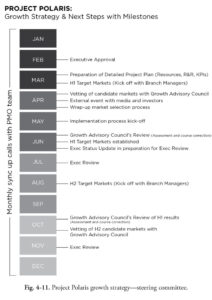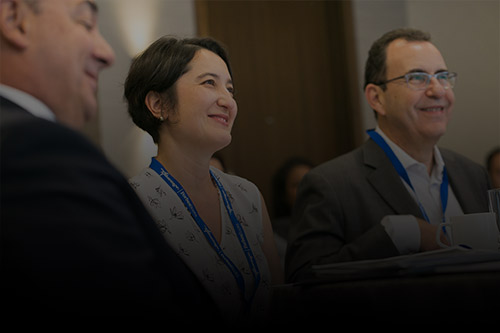In previous blog posts in this series, we’ve discussed the Identify, Design and Engage steps from our I.D.E.A.S. Framework, fully detailed in our book From Problem Solving to Solution Design (Campos & Campos, 2018). There are multiple potential challenges in each step of the I.D.E.A.S framework. I’m focusing on just one challenge per article in this series.
After Identifying the problem, Designing a solution by setting goals and assessing options, then Engaging stakeholders with a carefully crafted plan, we Act on our solution implementation. This means creating and driving a strategy to get it done!
Unfortunately, some inexperienced Solution Designers do not prepare well for the day after the decision-makers approve their recommended solution. They forget that a beautifully designed solution must become an actual project and be implemented accordingly in order to get through the finish line and drive the promised results.
This is a critical checkpoint because a significant number of projects fail in the implementation process.
In 2017, the Project Management Institute (PMI) reported that bad estimates, scope changes, and insufficient resources were the main reasons that about one third or more of projects failed during implementation. An option-implementation analysis, where the level of difficulty is considered for each of your options, can be started early on in the solution design process.

In the Act phase, you’ll want to update this analysis, as well as the Stakeholder Engagement Plan, if necessary. Some questions to consider include: (1) Does the plan include all the key stakeholders? and (2) Are you seeing the level of support you expected? If not, then you need to ask: (1) Was the plan realistic? and (2) Do you need to change the plan?”
The “people component” should be considered front-and-center in any scenario throughout the Solution-Design process.
Key challenges in the ACT step include:
- Solution implementation strategy and project management
TIP: Consider hiring or assigning a Project Manager (PM). - Solution implementation and communications
TIP: The PM may spend 70% of their time communicating with other people! - Governance model and committees
TIP: The Committee of Sponsoring Organizations (COSO) provides a framework for governance models. (https://www.coso.org/) - Committees and how to leverage them
TIP: Speaking in tongues confuses your audience.
We will focus on Challenge #4: Committees and how to leverage them.
Working with committees helps you to build your decision model based on aligning common objectives. Thus, it’s important to understand the stakeholders—which in this case are the committee members. This is a structured way to ensure all relevant parties are represented and all voices are heard. For your organization, it is a way to demonstrate that these parties play an important role in a transparent decision-making process — and this is one of the most recurrent requirements of regulatory bodies across the globe.
Besides being the structured decision-making body, committees can also serve as informative forums, working to uncover information that will educate committee members tasked to make the decisions. This is what differentiates working committees from steering committees or boards of directors. Working committees have a more operational role, usually composed of senior managers overseeing processes and operational activities. They are closer to the “action.” These committees can provide a detailed assessment for options to address the topics escalated to the steering committees or to boards of directors. These can include implementation timelines, resources needed, and impact analysis for each of the proposed solutions. Steering committees are composed of senior leaders who are accountable for driving resolutions, and who benefit from the details provided by the working committees to make an informed decision.
Make sure your message is adequate for your audience. For example, if you are presenting your point to a working committee, you will need to be equipped with operational details.

If your audience is the board of directors, or a steering committee, keep your message at the strategic level. Your audience will be more interested in an “impact vs. likelihood” analysis, preferably presented on one page with a simple chart.

In addition, you can drive effectiveness and efficiency by bringing to the committees only those questions that are not outlined in policies or procedures. In other words, those requiring further analysis and decisions that might be inconsistent due to variables that cannot be anticipated by standard policies and procedures (so-called “gray areas”).
Here is a case study demonstrating the importance of adjusting your communication to the right audience.
Lillian Hu, the Chief Information Security Officer (CISO) in a global telecommunications powerhouse, was set to present her recommended solution for secure communications to the company’s board of shareholders. On her way to the meeting, she reflected on the task at hand.
The Problem: Lillian’s organization had faced many leakages of sensitive information in the last several months. The last straw had been the publication of the latest plan to acquire one of the company’s competitors, which ended up showcased on the front page of a major media outlet.
The Issue: Lillian planned to present her solution to the Board of Directors with assistance from Luigi, a young cyber security professional and a national expert in the encryption field. But at the time of the meeting, Lillian was called away on an emergency and Luigi was left to give the presentation.
After a thorough internal investigation, an external auditor identified the source of the leakage as a notebook that had gone to recycling without having the sensitive data fully deleted. Lillian’s recommended solution included encryption, a review of the IT recycling policy and an employee awareness campaign. Lillian was a seasoned executive and an effective and experienced solution designer. She knew how to prepare for sharp questioning, thorough assessment and challenging questions that can test a presenter’s preparedness.
Luigi began his presentation well, explaining the revamped IT recycling policy, the awareness campaign, and the respective benefits. The board rejoiced with the supporting data, the solution comparison with the market, and the estimated costs. Luigi became overly confident with his performance, and this led him into a trap. When Luigi got to the encryption section, he started babbling about keys, the number of its bits, and the mathematical formulas behind each algorithm used in the recommended solution. He was so excited with his own knowledge that he did not notice the audience smiles morphing into questioning smirks, the sweat drops forming on the CFO’s forehead, and the bleary eyes of the Chairman of the Board nervously squinting. It appeared that Luigi’s performance was doomed, and he was the only one not realizing it. That’s when destiny came to his rescue and Lillian opened the door, interrupting him.
Before Lillian could say anything, the Chairman said, “Lillian, it is clear you and Luigi know what you are doing. However, for the last third of the session no one could understand a bit of what Luigi was saying. Please, reschedule the presentation and come back prepared to speak in the mortal language!”
The situation created by Luigi’s disconnection with his audience happens more frequently than you can imagine. Many times, excellent solutions are not approved because presenters are not prepared to speak the audience’s language. When the audience is made up of board members, senior management, or non-experts, it is even more important to use clear pictorial exhibits with verifiable supporting data. Avoid speaking in tongues; skip using complex jargon and technical terms. Ensure that you connect with your audience by using a common language.
In our next article we will look at “S – Sustain” from our framework and review another challenge and case study.
Key Tips for the Act Step:
- Begin with a well-planned Solution Implementation Strategy as well as great project management.
- Drive solution implementation on top of great communications and speak your audience’s language.
- Create a strong Governance Model and leverage known frameworks.
- Engage committees and leverage them to support your solution-implementation.
Click here to read the Introduction to this series.
Click here to read the post Identify the problem.
Click here to read the post Design a solution.
Click here to read the previous post in this series, Engage your stakeholders
Resources:
- Click here for more on From Problem Solving to Solution Design
- Click here for a free chapter from the book.
- Are you offering solutions that matter? Click here for a free Solution Design assessment.
- Click here for additional articles, interviews and podcasts.
- Click here to learn more about the COSO framework.
